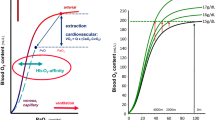Abstract
The effects on rats of 6 weeks of altitude acclimatization (25,000 ft 5 hrs/day) on exercise performance (slow walking in a cylindrical wire cage for 9 hours) at sea level were determined. The altitude acclimatized rats developed incipient fatigue (immobility of either fore or hind limbs) three hours earlier than unacclimatized controls. Fatigue (total immobility of both fore and hind limbs)was exhibited by all altitude rats and in one-third of the controls after exercising 7 1/2 hours. The reduced exercise performance of altitude rats was correlated with greater elevations in the serum of corticosterone, urea nitrogen, glutamic oxalacetic and glutamic pyruvic transaminases, aldolase, and lactic and malic dehydrogenases. It was also correlated with a marked polycythemia and focal myocardial inflammation and scarring. Hypoglycemia after exercise was also more severe in the altitude acclimatized rats. Thus, as indicated by the ensuiing physiological, biochemical and histopathological changes, 6 weeks of altitude acclimatization proved detrimental to rats exercising at sea level.
Zusammenfassung
Es wurde die Auswirkung einer 6-wöchigen Höhenakklimatisation von Ratten (täglich 5 Stunden in 6.600 m Höhe in der Unterdruckkammer) auf die Laufleistung in Seehöhe (langsames Laufen in einer Lauftrommel mit Pausen während 9 Stunden) untersucht. Die höhenakklimatisierten Tiere zeigten Zeichen von Müdigkeit (Schleppen der Vorder- oder Hinterbeine) 3 Stunden früher als die nicht exponierten Kontrolltiere. Müdigkeit (totale Immobilität der Vorder-und Hinterbeine) trat bei allen Höhen-Ratten und bei ein Drittel der Kontroll-Ratten nach 7 1/2 Stunden Laufen auf. Die verminderte Laufleistung der Höhen-Ratten war verbunden mit grösserer Erhöhung von Corticosteron, Harnstoff-N, GOT und GPT, Aldolase und Milch- und Apfelsäure-Dehydrogenase im Serum. Ebenfalls bestand eine ausgeprägte Polyzythämie und herdförmide Myokardentzündung und Narbenbildung. Die Hypoglykämie nach Arbeit war bei den Höhen-Ratten schwerer. Danach hat diese Form der 6-wöchigen Höhenexponierung einen nachteiligen Einfluss auf Ratten im Arbeitstest.
Resume
On a examiné l'effet de l'acclimatation à l'altitude de rats (exposition journalière durant 5 heures à 6.600 m d'altitude simulée dans un caisson décompressé) sur leur aptitude à marcher au niveau de la mer (déplacement ralenti à l'intérieur d'un cylindre durant 9 heures avec des interruptions). Les bêtes ayant subi un traitement au caisson ont montré des signes de fatigue (trainage des pattes antérieures ou postérieures) 3 heures avant les bêtes de contrôle. La fatigue (immobilité totale des pattes antérieures et postérieures) se remarque après 7 1/2 heures de marche chez tous les rats acclimatés à l'altitude et chez un tiers des bêtes de contrôle. La diminution de la résistance à la marche était accompagnée chez les rats d'altitude d'une augmentation notable des principes suivants dans le sérum sanguin: corticosterone, urée azotée, GOT et GPT, aldolase et déshydrogénase des acides lactique et malique. On a constaté également une polycythémie ainsi qu'une inflammation du myocarde accompagnée de cicatrisation. Après le travail, l'hypoglycémie était également plus prononcée chez les rats acclimatés à l'altitude que chez les autres. Il s'ensuit que cette forme d'exposition à l'altitude en 6 semaine a des suites fâcheuses sur les possibilités d'activité des rats.
Similar content being viewed by others
References
ADOLPH, E.F. (1956): General and specific characteristics of physiological adaptations. Amer.J.Physiol., 184: 18–28.
ALTLAND, P.D. and HIGHMAN, B. (1961): Effects of exercise on serum enzyme values and tissues of rats. Amer.J.Physiol., 201: 393–395.
ALTLAND, P.D., HIGHMAN, B. and GARBUS, J. (1964): Exercise training and altitude tolerance in rats: Blood, tissue, enzyme and isoenzyme changes. Aerospace Med., 35: 1034–1039.
ALTLAND, P.D., HIGHMAN, B., NELSON, B.D. and GARBUS, J. (1966): Effects of dimethyl sulfoxide on serum enzymes and tissues in exercised rats. Life Sci., 5: 375–383.
BALKE, B., FAULKNER, J.A. and DANIELS, J.T. (1966): Maximum performance capacity at sea level and at moderate altitude before and after training at altitude. Schweiz.Z.Sportsmed., 14: 106–116.
BALKE, B., NAGLE, F.J. and DANIELS, J. (1965): Altitude and maximum performance in work and sports activity. J.Amer.Med.Ass., 194: 646–649.
BARBASHOVA, Z.I. (1967): Studies on the mechanisms of resistance to hypoxia. A Review. Int. J. Biometeor., 11: 243–254.
DALTON, A.J., JONES, B.F., PETERS, V.B. and MITCHELL, E.R. (1945): Organ changes in rats exposed repeatedly to low oxygen tension with reduced barometric pressure. J.nat.Cancer Inst., 6: 161–185.
FREGLY, M.J. (1954): Cross-acclimatization between cold and altitude in rats. Amer.J.Physiol., 176: 267–274.
GARBUS, J., HIGHMAN, B. and ALTLAND, P.D. (1964): Serum enzymes and lactic dehydrogenase isoenzymes after exercise and training in rats. Amer.J.Physiol., 207: 467–472.
GUILLEMIN, R., CLAYTON, G.W., LIPSCOMB, H.S. and SMITH, J.D. (1959): Fluorometric measurement of rat plasma and adrenal corticosterone concentration. J.lab.clin.Med., 53: 830–832.
HECHT, H.H. (1967): Certain vascular adjustments and maladjustments at altitudes. Exercise at Altitude. R. Margaria (ed.), Excerpta Med. Found., Amsterdam, 189–200.
HIGHMAN, B. and ALTLAND, P.D. (1949): Acclimatization response and pathological changes in rats at an altitude of 25,000 ft.Arch. Pathol., 48: 503–515.
HIGHMAN, B. and ALTLAND, P.D. (1960): Serum enzyme rise after hypoxia and effect of autonomic blockade. Amer.J.Physiol., 199: 981–986.
HORECKER, B.L. (1943): The absorption spectra of hemoglobin and its derivatives in the visible and near infra-red regions. J.biol.Chem., 148: 173–183.
KLAUSEN, K., ROBINSON, S., MICHAEL, E.D. and MYRHE, L.G. (1966): Effect of high altitude on maximal working capacity. J.appl.Physiol., 21: 1191–1194.
REEVES, E. (1961): The effect of acclimatization to cold on the G tolerance of rats. U.S. Naval Air Development Center, NADCMA-6117, Report # 6.
SEGAL, N. and BISHOP, J.M. (1967): Circulatory studies in polycythemia vera at rest and during exercise. Clin.Sci., 32: 527–549.
VALESQUEZ, T. (1966): Acquired acclimatization: To Sea Level. In Life at High Altitudes. Pan American Health Organization, Washington, D.C., Scientific Publication No. 140: 58–63.
VAN LIERE, E.J. and STICKNEY, J.C. (1963): Hypoxia. University of Chicago Press, Chicago, 381 pp.
Author information
Authors and Affiliations
Rights and permissions
About this article
Cite this article
Altland, P.D., Highman, B. & Dieter, M.P. Reduced exercise performance of rats at sea level after altitude acclimatization: Changes in serum enzymes, glucose, corticosterone and tissue structure. Int J Biometeorol 13, 173–181 (1969). https://doi.org/10.1007/BF01552738
Issue Date:
DOI: https://doi.org/10.1007/BF01552738




